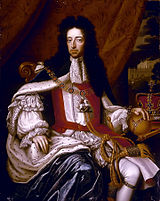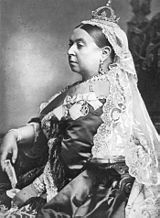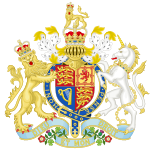- Crown and Parliament Recognition Act 1689
-
The Crown and Parliament Recognition Act 1689 (2 Will & Mar c. 1) was an Act of the Parliament of England, passed in 1689. It was designed to confirm the succession to the throne of King William III and Queen Mary II of England and to confirm the validity of the laws passed by the Convention Parliament which had been irregularly convened following the Glorious Revolution and the end of James II's reign.
Contents
Reason for the Act
The Act was passed because in 1688 King James II of England was deposed (he was deemed to have abdicated) and replaced as king by William and Mary, who ruled jointly. However this could not be achieved without an Act of Parliament to approve it. Since no parliament was in existence at the time, it was necessary to convene one, but under the constitution only the King could summon a parliament. In the absence of a king to do so, the members of the previous parliament convened a new one themselves, without a royal summons, instead asking William to issue the summons, which he did on January 22, 1689. This irregular Parliament sat on February 13. They declared James to have abdicated, and then chose Mary (his daughter) and William (her husband and first cousin) to succeed him, and passed an Act to make it legal. This Act was the Bill of Rights 1689. (In Scotland a separate Act was passed, the Claim of Right, which stated that James had forfeited the throne by his illegal actions and his failure to take the coronation oath.)
However, doubts arose as to the validity of the Bill of Rights and the other Acts passed by the Convention Parliament. Since the Parliament had not been summoned in the regular way, it was arguable that it was no parliament at all and its legislation was of no legal effect (although this occurrence was not unprecedented in English history). Therefore after the Convention Parliament was dissolved and the next parliament was summoned by the King and Queen in the normal manner, the Crown and Parliament Recognition Act was passed to confirm the validity of the royal succession and the previous parliament's legislative competence.
Controversy
The difficulty with the Act is that if the Convention Parliament had no authority, then the succession of William and Mary was of no legal effect, which meant that they were not capable of giving Royal Assent to any bill in the next parliament, with the result that even the Crown and Parliament Recognition Act was of no effect either. This very point was argued before the Hereford County Court in 1944 by a litigant who represented himself in a probate case called Hall v. Hall.[1] He argued that the Court of Probate Act 1857 (which undermined his case) was of no legal effect whatsoever, since it had never received Royal Assent. It had received Royal Assent from Queen Victoria, but according to his argument Victoria had never legally inherited the throne, because the Bill of Rights and the Act of Settlement 1701 (which also altered the line of succession to the throne) were of no effect, since both had been assented to by William III, who was not the real king. Therefore Victoria had never been the real queen and so the Probate Act (like every other Act passed since 1689) was not the law. Understandably, the judge ruled against him, and the point has never been argued in court since.
Although the judge did not give detailed reasons for his decision, a counterpoint to the above argument has been advanced by academics: "One possible answer, deducible from rationalizations of later medieval practice when usurpations of the throne were not uncommon, is that ... [a]s a matter of State necessity ... a de facto King had been regarded as competent to summon a lawful Parliament."[2]
Text of the Act
"An Act for Recognizing King William and Queene Mary and for avoiding all Questions touching the Acts made in the Parliament assembled at Westminster the thirteenth day of February one thousand six hundred eighty eight. [Note: this date is given in the Old Style calendar.]
Wee your Majestyes most humble and loyall subjects the lords spirituall and temporall and commons in this present Parlyament assembled doe beseech your most excellent Majestyes that it may be published and declared in this High Court of Parlyament and enacted by authoritie of the same that we doe recognize and acknowledge your Majestyes were are and of right ought to be [by] the laws of this realme our soveraigne liege lord and lady King and Queene of England France and Ireland and the dominions thereunto belonging in and to whose princely persons the royall state crowne and dignity of the said realms with all honours stiles regalities prerogatives powers jurisdictions and authorities to the same belonging and appertaining are most fully rightfully and intirely invested and incorporated united and annexed. And for the avoiding of all disputes and questions concerning the being and authority of the late Parliament assembled at Westminster the thirteenth day of February one thousand six hundred eighty eight wee doe most humbly beseech your Majestyes that it may be enacted and bee it enacted by the King and Queenes most excellent Majestyes by and with the advice and consent of the lords spirituall and temporall and commons in this present Parlyament assembled and by authoritie of the same that all and singular the Acts made and enacted in the said Parlyament were and are laws and statutes of this kingdome and as such ought to be reputed taken and obeyed by all the people of this kingdome."
Ireland
In the Kingdom of Ireland another act, entitled An Act of Recognition, of their Majesties [sic] undoubted Right to the Crown of Ireland was passed in 1692 by the Irish parliament, which made similar provision.[3]
See also
- Treason Act 1702
- Parliament Act 1660
References
- ^ Hall v Hall (1944) 88 SJ 383
- ^ Constitutional and Administrative Law, de Smith, Stanley; and Brazier, Rodney; London: Penguin Books, 8th ed. (1998), ISBN 0140258167, page 71, footnote 11.
- ^ 4 Will. & Mar. c.1
External links
- Official text of the Crown and Parliament Recognition Act 1689 as amended and in force today within the United Kingdom, from the UK Statute Law Database
- Official text of the Crown Recognition Act (Ireland) 1692 as amended and in force today within the United Kingdom, from the UK Statute Law Database
 United Kingdom legislation
United Kingdom legislationPre-Parliamentary legislation Acts of Parliament by states preceding
the Kingdom of Great BritainActs of the Parliament of England to 1483 · 1485–1601 · 1603–1641 · Interregnum (1642–1660) · 1660–1699 · 1700–1706
Acts of the Parliament of Scotland
Acts of the Parliament of Ireland to 1700 · 1701–1800Acts of Parliament of the
Kingdom of Great Britain1707–1719 · 1720–1739 · 1740–1759 · 1760–1779 · 1780–1800
Acts of Parliament of the United Kingdom of
Great Britain and Ireland and the United
Kingdom of Great Britain and Northern IrelandChurch of England Measures Legislation of devolved institutions Acts of the Scottish Parliament
Acts and Measures of the Welsh Assembly
Acts of the Northern Ireland Assembly / of the Northern Ireland Parliament
Orders in Council for Northern IrelandSecondary legislation Categories:- Acts of the Parliament of England
- Acts of the Parliament of England still in force
- Constitutional laws of England
- 1689 in law
- 1689 in England
- United Kingdom constitution
Wikimedia Foundation. 2010.





